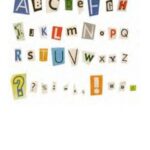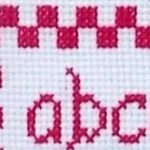Recently, a number of my readership has inquired about my methods for teaching children the letters of the alphabet. I greatly value the support of my readers, so as requested, here is the method I have been using. It has proven successful a number of times.
For optimal success, follow the method exactly. It is designed so that the child will fully comprehend each letter and its sound before moving on to reading. This will help the child progress into and master reading much easier. Skipping steps or goals may hinder the process.
Teaching your child the letters of the alphabet can be a real joy for you as well as your child. It will be the foundation for your child’s education. A child must know the letters in order to read. In order to do most other lessons, a child must be able to read properly. When students struggle in school, many times it will be traced back to their reading skills. If a child has never learned appropriate reading skills, failure is inevitable.
With younger children who are just beginning to learn the concepts of reading, rather than forming a set schedule, I find that setting goals and meeting them is much more effective. Once a child meets a goal, the child can then excel to the next, but never sooner. In this way, the child can be sure to learn each concept to the fullest.
This type of instruction is best for early learners because there may be some moments (or even days) when a child this young is too frustrated to learn and that’s okay. A happy child is a child who is willing to learn. A child who is frustrated and pushed to their limits will more than likely be unwilling to learn. As I say all the time, “5 minutes of working with a willing child is much more effective than 5 hours of working with a frustrated child”. Look for signs that the child is in an appropriate mood to learn and is not nervous,distracted, or unhappy.
The Concept
In order for each letter and it’s sound to fully register with a child, learning them individually is a must.
Below are instructions on how to do so, some with corresponding links. These instructions should be applied to each letter one at a time. Do not move on to the next letter until your child has mastered the previous letter.
Goals 1 -3 below should be done in order once per day until your child has mastered all of the letters and goals. Once that is done, your child can work on the following goals one at a time. When those goals are mastered, your child is ready to begin reading.
Teaching Your Child The Alphabet Letters Goal#1
Flashcards work well for this. You can purchase your own or print some by clicking here, or if you prefer black and white from here. It’s best to show both capital and lowercase. Show the letter your child is learning. Point to it and say it’s name.
Specify between capital and lowercase. Be sure to always show both capital and lowercase. Always say the sound of the letter afterwards. For example, an instructional sentence could go like this: “This is capital A. A says (insert “a” sound here). This is lower case “a”. A says (insert “a” sound here).
Also, be sure to give all the sounds for each letter that has more than one sound. To do so, start with one sound, introducing the next after the child has mastered the first, eventually making it so that the child knows all possible sounds for the letter.
Teaching Your Child The Alphabet Letters Goal #2
Next, you should gather some household objects and pictures that start with the letter. Say the letter and say it’s sound. Then, point to each object and say the sound of the letter and the name of the object. After each object’s name is stated, repeat the name and sound of the letter.
Teaching Your Child The Alphabet Letters Goal #3
Go to Starfall.com and click on “ABC’s”. Click on the letter you are working on. Follow through all the exercises for that letter. If you are doing a vowel, click on the lowercase version of it at the bottom of the other letters and do those activities with your child as well. While the child can play this game independently, it is important for you to play it together, pausing to discuss what is going on, dance to the music, or ask your child questions about what is going on.
Teaching Your Child The Alphabet Letters Goal #4
Print out (or purchase) some primary writing paper. Click Here To Print Some. Have your child practice making circles and straight lines. Once your child has mastered this, start having your child trace and draw letters and move on to goal 5. For a hint on how to make the paper last longer, click here and read the section titled “schoolwork” on page 2 of the article.
Teaching Your Child The Alphabet Letters Goal #5
Next, you’ll want your child to complete a few worksheets for each letter (one at a time – don’t make your child do them all in one sitting).
Here are some great worksheets for that:
Set 1
Set 2
Set 3
Set 4
Set 5
Remember to focus on one letter at a time. Be sure your child has fully mastered one letter before moving on to the next. Moving on too early can cause confusion when it’s time to learn to read. That’s exactly what you don’t want.
Handy Hints
I also like the children to play various alphabet games that I make up, in addition the above goals. When a child is learning letters, it’s also important to associate the letters with other aspects in their lives, such as pointing out letters on food packages and singing the alphabet song during play time. Adding a variety of ways to enjoy the alphabet without overwhelming the child can go a long way in assuring the child knows and properly understands the letters and what they are for.
Overview
Remember that your child must master one step at a time in the learning steps for each letter. Do not move too quickly. When the step gets easy for your child, that’s when it’s time to move to the next step, not a moment sooner. Remember what your ultimate goal is. Your ultimate goal should be for your child to not only know the letters, but know them well. The difference between knowing them and knowing them well can be the difference between a child’s failure and success in school.
*Note: The author does not guarantee success. All children respond to ideas differently. However, the author does give her word that this method has proven successful a number of times.
~~
Like this idea? Have another idea? Just have something to say? This author welcomes feedback and discussion in the comments section below.
This lesson has a follow-up reading lesson, set to publish soon afterward.
To read more from this author, simply click on her name above.




